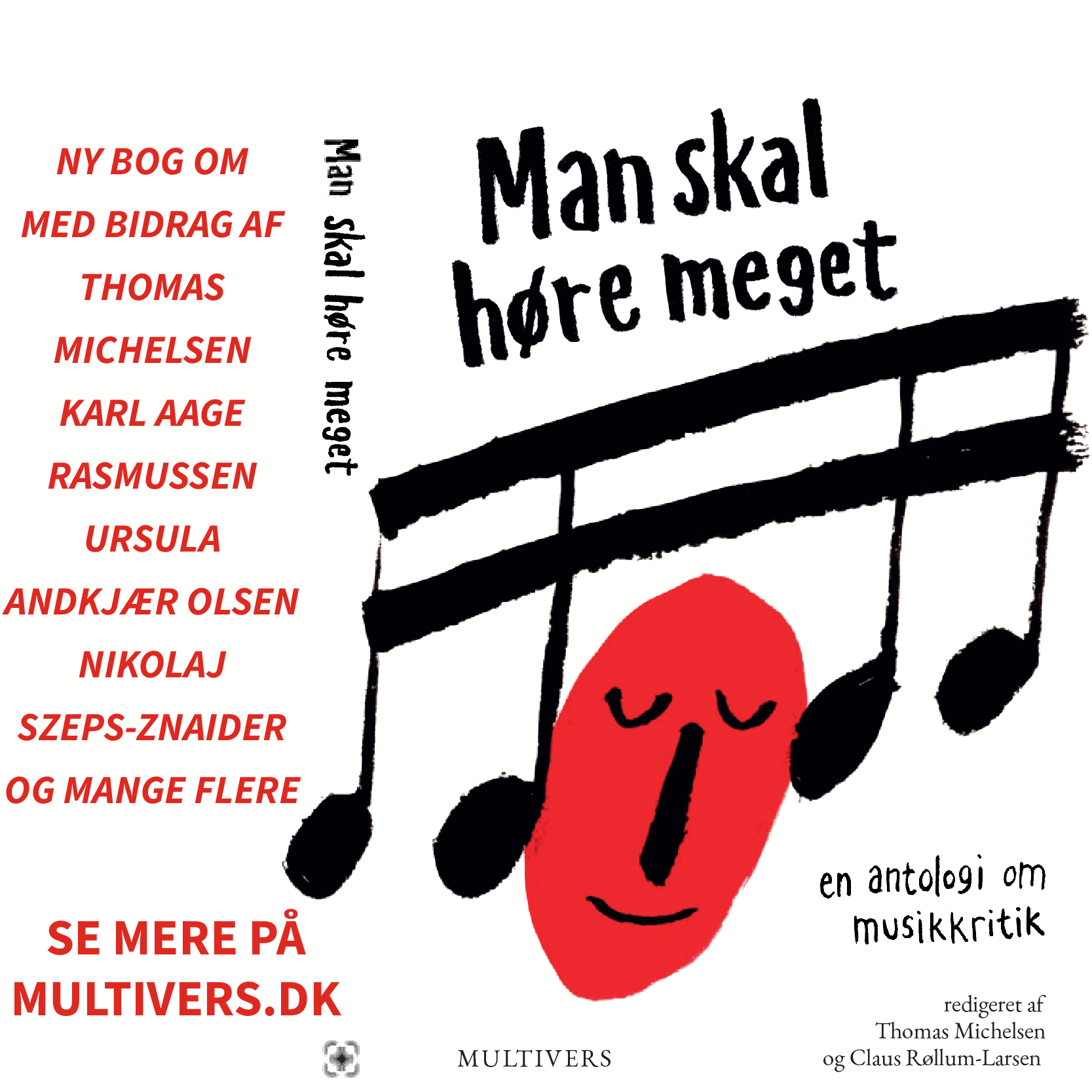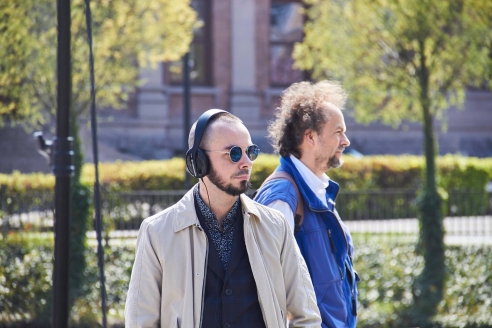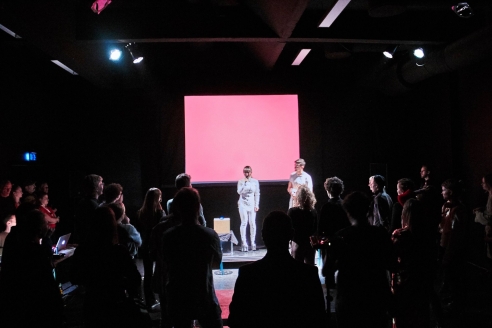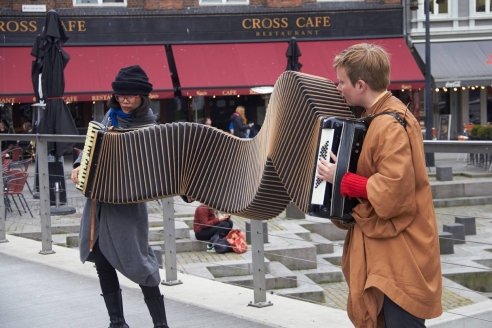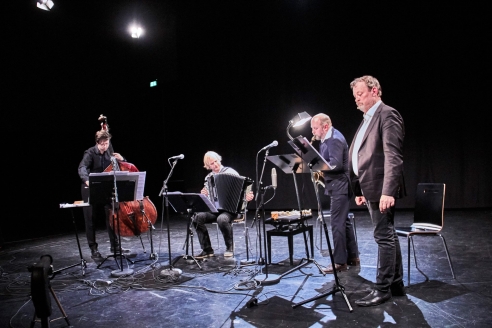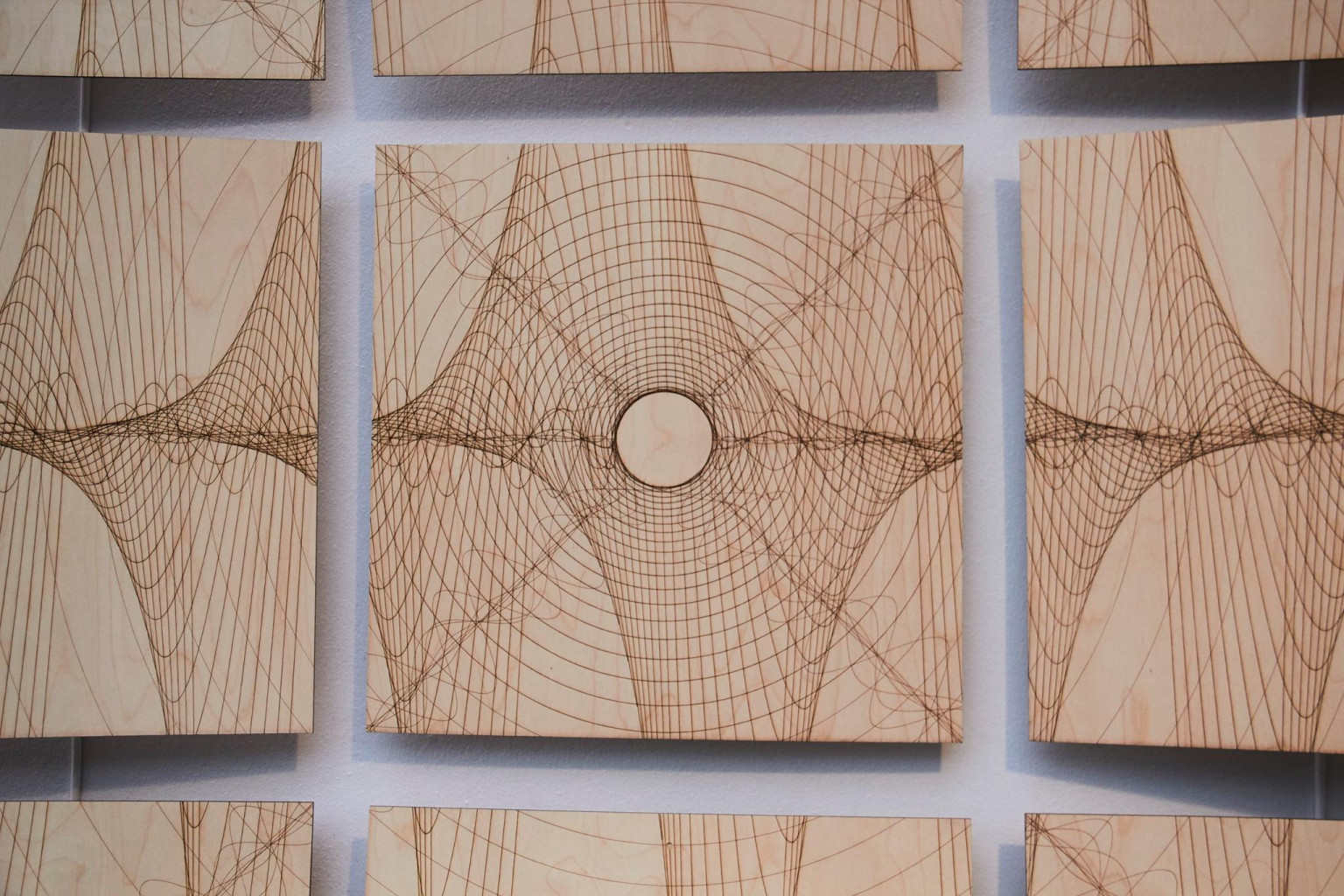
Eavesdropping on ourselves
»I am not paranoid or anything«, said Zeno van den Broek as he introduced his installation Panauditum at Kunsthal Aarhus on the afternoon of Store Bededag, »but it would be nice, in this surveillance society, if we had some awareness of how valuable our voices are as sonic fingerprints.«
The idea of the voice as a sonic fingerprint – specifically, the human speaking voice – thread its way through SPOR 2017, at least for the two days I dipped into the festival in Aarhus. The actual theme was ‘epiphany’, in which SPOR’s programmers sought to unearth »the magical and inexplicable aspects of everyday life.« The human voice is about as ‘everyday’ as sound gets, but its magical qualities vary considerably.
Van den Broek’s work asked some pertinent questions about surveillance practices by sucking up and spitting out fragments of speech from visitors to the gallery in which it was situated. The composer seemed half disgusted by the process and half enchanted by it. You never know if you’re being spied upon, he told us, while also expressing some regret that we collect and store photographs of our physical selves but rarely have equivalent documents of our own voices.
The difference, of course, is one of choice. I wonder if Van den Broek had dropped by Mølleparken two hours earlier, where the composer Martin Andreas Hirsti-Kvam had set up an elaborate system of microphones that picked up sounds from all over the park in real time. Hirsti-Kvam’s ‘site-specific city soundwalk’, transmitted via high-definition ear covering headphones, provided one of the most frightening and beautiful explorations of consciousness I have experienced in some time.
In addition to the unsettling reality of the composer eavesdropping on potentially private, incriminating or embarrassing conversations across the park in real time (without warning us, as Van den Broek had done), we the participants were treated to the creeping disorientation of having one of our primary senses tricked; is an out of control airplane hurtling towards me? Is a swarm of bikers roaring past the park?
The answers were respectively ‘no’ and ‘yes’, which is a good indication of how delicately the piece walks the line between reality and manipulated reality. Just when we thought the sun-drenched park with its rippling fountain couldn’t get any more beautiful – this spring day no more perfect – Hirsti-Kvam’s voice appeared in our ears to tells us we were listening to sounds recorded ‘a week ago on an island outside Oslo’. Okay then. At least we knew the gentle tapping of a Ping-Pong game was real: two festival assistants were playing it on a table rigged with microphones thirty yards away.
The programme book promised Hirsti-Kvam’s Hyperrealities would »envelop the participants, raising their awareness of themselves, their actions and their surroundings«. On the evidence of how intensively we listened for ten minutes and how carefully and quietly we walked away, it was a mission accomplished. In a sense, the piece is rampant and opportunistic. In another, it is delicate and carefully considered right down to the composer’s discriminating deployment of his own vocal fingerprint, wrapped in a petal-like Norwegian accent, to offer fragments of information.
Viola karaoke
The same can’t be said for Jagoda Szmytka, who turned up in a few guises during SPOR 2017 and wrapped-up the first full day of activities with her loud-mouthed experimental show in collaboration with the violist Stephen Upshaw entitled Voila! That’s my Life. Reading the programme book synopsis after the event, comparing its commentary to my own scribbled account of what actually happened in an upstairs room of Teater Refleksion, posed a riddle in itself. We were promised a ‘unique sensory experience’, but the nearest the show gets to that is offering up Britney Spears’ Hit Me Baby One More Time played on Upshaw’s viola to a karaoke backing track.
As a tool for demonstrating how far art music has gotten itself from the everyday discourse – yet how paradoxically close it remains – a slice of Britney on a viola makes its point clearly enough. But the delivery here was mega-awkward, coming after Szymtka’s artistic ‘manifesto’ (a series of simplified dictates which were meant ironically, but the joke fell flat) and the unfathomable mime act that opens the show proper. In the end, Szmytka’s sudden imploring of the audience felt like a reaction to her show losing tension and altitude. Which didn’t do her own vocal fingerprint many favours.
Mutant accordion
The problem is that Szmytka apparently insists either on over-complicating her material or over-simplifying it (sometimes it’s not entirely clear which) and that points to a bigger problem with the material itself. The beauty of Sustained Effort by Sandra Boss and Ea Borre is that the material is so strong (and yes, simple) that there is no need to cook it up into something flaccid and unsustainable.
As it happened, Sustained Effort is both flaccid and unsustainable on occasion, but only in a literal sense as Katrine Møllebæk and Ying-Hsueh Chen struggle to control the giant accordion fashioned by Ea Borre and it sags in the middle, losing its voice. The two-person accordion is treacherously difficult to play, as referenced in Ying-Hsueg Chen’s comic body language as the two literally stretch out a cadence over a period of minutes.
At full deployment (around ten feet) the instrument becomes unreliable and unwieldy, which creates immediate tension as the audience and players hold out hope that its voice won’t falter. The theatrical subtext – that the two players aren’t entirely in agreement about the best way to sustain the beast’s sound, to keep air in its lungs – says rather more about the exaltation and frustration of artistic collaboration than Szmytka sitting enraptured while Upshaw played his viola.
The fragility of the mutant accordion’s notes in Sustained Effort, and the physical display of how those notes were coming into being, prepared the ground for Christian Winther Christensen’s Chorale which followed a few hours later. In Chorale, we experience some of the same principles laid out in Christensen’s Double Concerto Chromatische Weltmusik (for cello and accordion) as presented at Pulsar in Copenhagen in March 2016.
Chorale, for pianist, string players, woodwind players and two guitarists (scored for the people, not just for their instruments) is concerned, like the concerto, with the performance process: a charming, questing, often hilarious and consistently beautiful piece in which Christensen mines ideas that are the natural successors to those laid out in Cage’s 4’33.
We see intense concentration and sometimes frantic activity, but what we hear is tiny, chiseled, delicate. It is as though some huge, writhing, rhapsodic performance is taking place elsewhere or being fed covertly into some external repository, perhaps into our collective imagination. There is an element of theatre in the piece but the experience is a deeply musical one. Amid all the quiet, there is a sudden ecstasy of fumbling, pedaling and tapping just before the work’s conclusion after which Ensemble Scenatet’s pianist was allowed to suggest the embedded chorale more keenly than before, which he did with a flourish.
Chorale views ensemble performance as if from the wrong end of the telescope; the bits we’re not supposed to enjoy (tapping, scraping, flicking, clicking) become the foliage in which the odd snatch of concert music is stumbled upon. It might be tenuous, but I hear a similar reference to the ‘elsewhere’ in Matthew Rogers’ Weep at the Elastic as it Stretches, a multi-movement piece that often points us in the direction of notes that weren’t being played.
Harmonically, there are passages in which the three voices (bass clarinet, viola and cello) feel like elements of a four-part harmonic texture with one part missing – the fourth side of the square left gaping open. Sometimes the music emerges as if as a residual product of the physical geometry at play, the technique and the exercises; for all his tonal harmonies and traditionally produced notes, Rogers is urging us to listen to the sounds that are ‘out there’ and not ‘in here’. If anything can underline the idea of approaching something as if from the wrong side, it is the sound of the ensemble tuning-up that neatly brings the piece back down to earth and to its end. In retrospect, that was a useful bit of orientation, though it was easy to get lost along the way of Rogers’s sprawling score.
Seasonal change
SPOR 2017 had opened the night before in the same room of Godsbanen with De fire Årstider, a collaboration between Bent Sørensen and Tomas Espedal in which passages from Espedal’s diary-like novel Året are embedded within Sørensen’s music for POING Ensemble’s saxophones, accordion and double bass.
Espedal’s texts ask everyday questions of life and love; we glimpse a fraught relationship with women and alcohol from the protagonist talking in the first person who also takes nourishment from the changing of the seasons. Sørensen develops some techniques from the comparable score Sounds Like You but in a quicker, tighter, more focused context. Sometimes his music rises up and locks into the rhythm of the overlying speech, as in Britten’s Night Mail, or is welded phonetically to the words being spoken. Elsewhere, the voice dies away and the ensemble blossoms into Tristan-like lyrical angst, drifting for a consistent period into one of the composer’s favourite melodies. Typically, the musicians hum and sing as well as play.
Frode Haltli and his accordion know all too well how a Sørensen motif can slip tearfully through the fingers. But it is fascinating to witness the interplay between Rolf-Erik Nystrøm’s saxophones – not vessels known for their subtlety – and Sørensen’s general treatment of instruments as if they should be slightly embarrassed by their own sonorities.
Some way through, the piece arrives at Winter and the mysterious white-out of the first snowfall. This, yet another depiction of whiteness from composer, might well be musical highlight of the piece. We heard the shifting whiteness of a landscape and a period of time, not the whiteness of a gallery wall, with muffled movement and sure regeneration. The ‘newness’ of Sørensen’s sensation of snow makes itself felt with gentle shock – so strange yet so familiar, the essence of seasonal change.
As for the fingerprint of the composer, it was present in Aarhus not only in music but also in his voice, as he himself read Espedal’s texts, stood on stage with the ensemble. Sørensen didn’t read as an actor, but with the same combination of vulnerability and focus that exists in so much of his music. The ‘everyday’ that SPOR 2017 was on the hunt for is there in some of Espedal’s universal and often quite ordinary sentiments. But delivering them straight, as Sørensen did, only made their inherent familiarity and tension more cutting.
